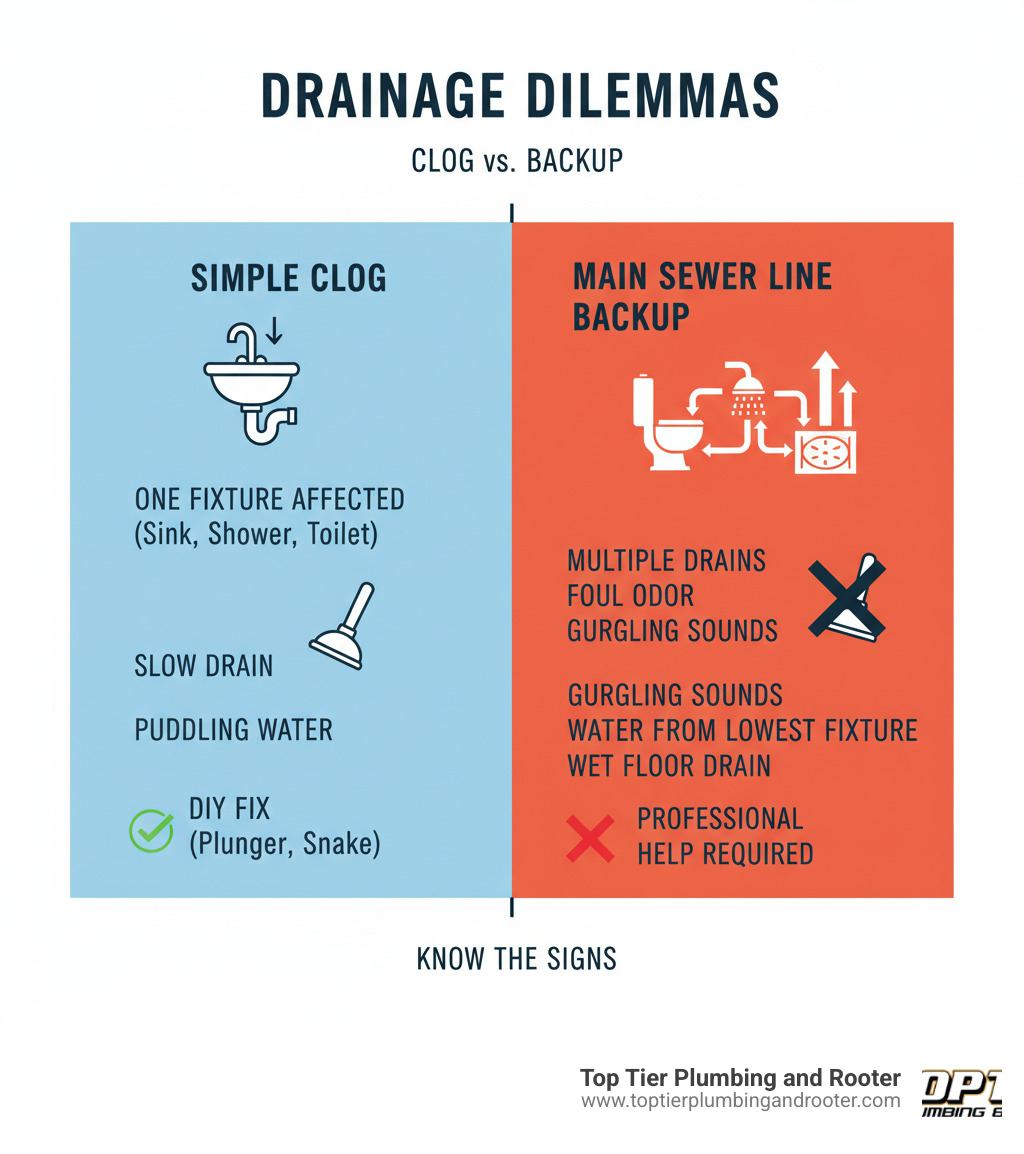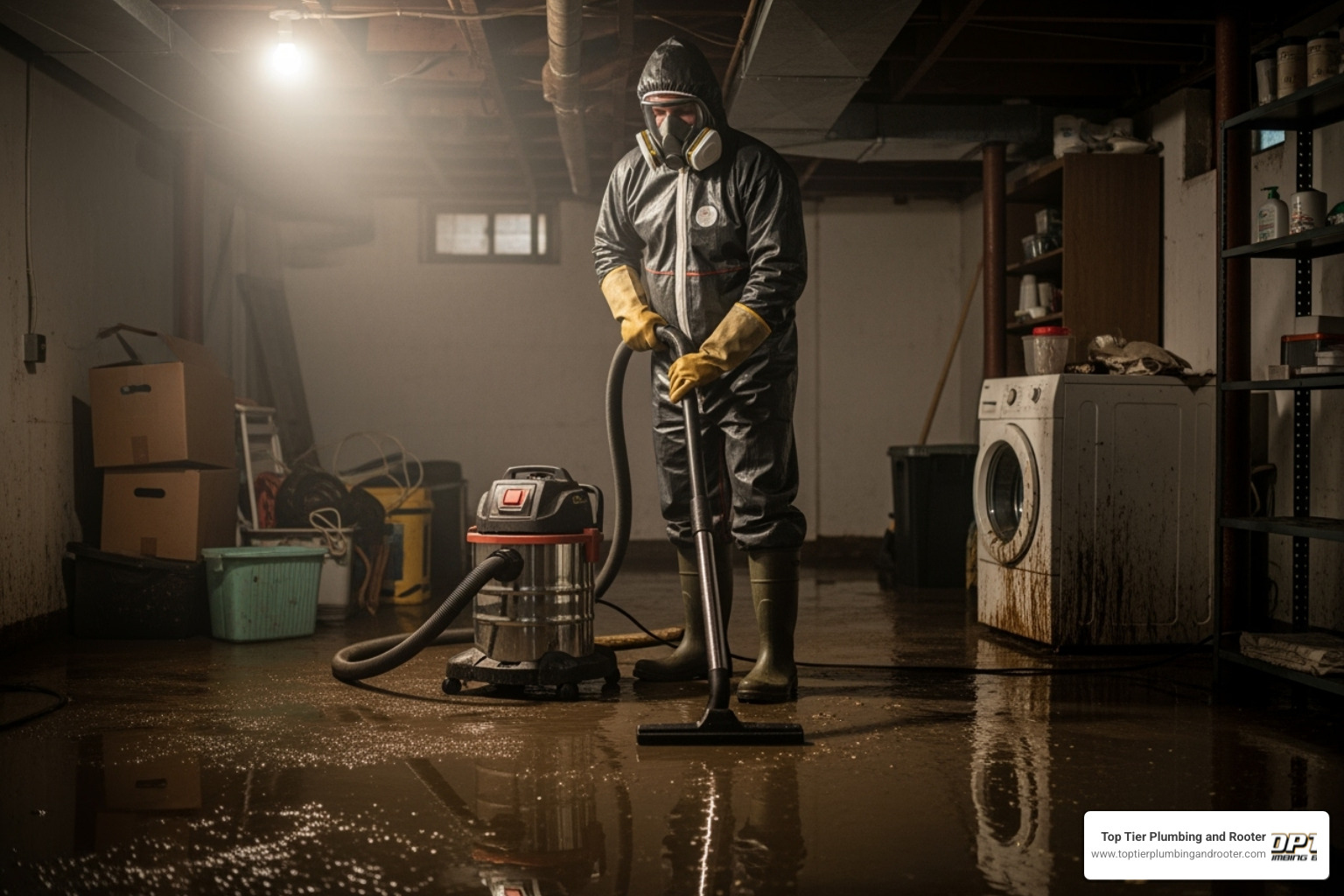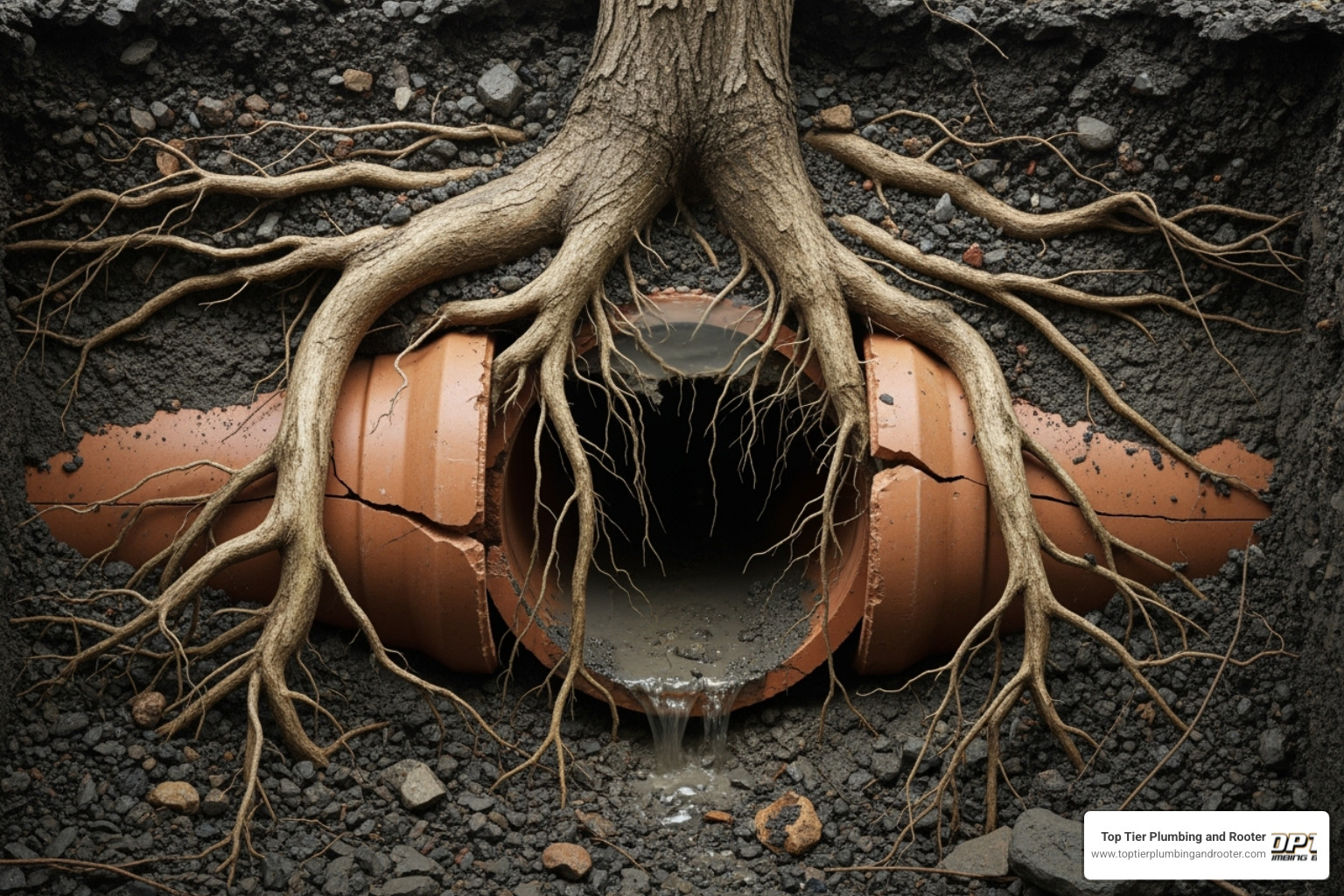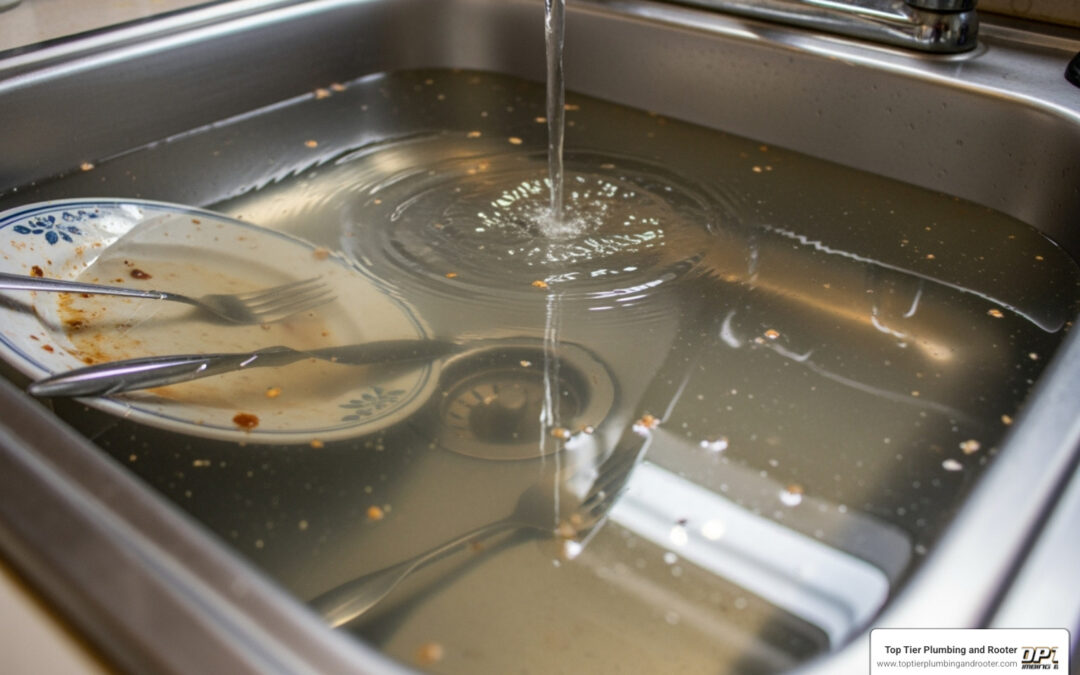When Disaster Strikes: Understanding Your Backed Up Drain
A backed up drain is a plumbing emergency. Standing water in sinks, sewage odors, or water backing up into your shower are all signs of a problem that can quickly become hazardous.
Quick Answer: How to Fix a Backed Up Drain
- Stop using all water in your home immediately
- Try a plunger for simple clogs in individual fixtures
- Check the P-trap under sinks for visible blockages
- Use a drain snake for deeper clogs in the line
- Call a professional plumber if multiple drains are affected or if DIY methods fail
Warning Signs You Need Professional Help:
- Multiple fixtures backing up at once
- Sewage smell throughout your home
- Water backing up in the lowest drain (basement floor drain or tub)
- Gurgling sounds when you flush the toilet
- Wet spots appearing in your yard
For homeowners in Riverside and San Bernardino counties, knowing when a clog is a simple DIY fix versus a serious sewer line issue is key. A slow sink might need a plunger, but sewage backing up into your home is a health hazard requiring immediate expert attention.
This guide covers warning signs, causes, DIY fixes, and when to call the pros, plus prevention strategies to avoid future backups.

Find more about Backed up drain:
Recognizing the Warning Signs and Taking Immediate Action
Your home’s plumbing gives you warning signs when trouble is brewing. Ignoring strange sounds, smells, or slow drains can lead to a costly disaster. Understanding The Hidden Dangers of Ignoring Drainage Issues: What Homeowners Need to Know is crucial for homeowners in Riverside and San Bernardino counties. Knowing how to spot these red flags and respond quickly can prevent a full-blown emergency.
Telltale Signs of a Sewer Backup
A backed up drain rarely happens without warning. Look for these early signals from your plumbing system:
- Gurgling noises from toilets or sinks when other fixtures are used indicate trapped air, a sign of a downstream blockage.
- Multiple slow drains at once strongly suggest a main sewer line problem, not an isolated clog.
- Bad odors mean sewer gases are backing up into your home because wastewater isn’t flowing freely.
- Water backing up from the lowest drain (basement or ground-floor shower) after using an upstairs fixture is a clear sign of a main sewer line blockage and requires urgent attention.
- Wet spots in your yard, soggy areas, or unusually lush patches of grass near your sewer line can indicate an underground leak or backup.
For a deeper dive, our guide on Sewer Clearing Emergency: How to Identify and Address Urgent Sewage Issues covers these critical situations.
Immediate Steps for a Backed Up Drain
When you suspect a main sewer line backup, quick action can prevent major property damage. Here’s what to do:
- Stop using all water. Do not run faucets, flush toilets, or use water-based appliances. Adding more water will worsen the backup.
- Turn off the main water supply if flooding occurs. The shut-off valve is usually where the water line enters your home (basement, crawl space). Turn it clockwise to stop the flow.
- Shut off electricity to flooded areas. If water is near outlets or appliances, turn off the corresponding breakers at your main panel to prevent electrocution.
- Locate your sewer cleanout line. Wearing gloves and eye protection, carefully remove the cap. This may release pressure and divert backed-up water outside, confirming a main line blockage.
- Keep people and pets away from the contaminated area. Raw sewage contains dangerous pathogens.
After taking these safety measures, call us immediately. We’re available 24/7 for emergencies. For more tips, see Emergency Plumbing 101: How to Handle Plumbing Issues Before Help Arrives.
Health Risks and Cleanup Procedures
A sewage backup is a serious health hazard. Raw sewage contains harmful bacteria, viruses, and parasites like E. coli and Salmonella. Exposure can cause illness, skin irritation, and respiratory issues. The moisture also promotes dangerous mold growth within 24-48 hours.

For small spills, follow these cleanup steps:
- Wear protective gear: Always use waterproof boots, heavy-duty gloves, eye protection, and a respirator.
- Remove standing water: Use a wet/dry vacuum.
- Dispose of contaminated materials: Porous items like carpet, drywall, and upholstered furniture must be bagged and disposed of according to local regulations. Non-porous items can be cleaned.
- Disinfect all surfaces: Scrub affected hard surfaces with hot water and a disinfectant, such as a diluted bleach solution.
- Dry the area completely: Use fans and dehumidifiers to circulate air and remove all moisture to prevent mold.
For extensive backups, we strongly recommend calling professional restoration services to ensure your home is safely and thoroughly cleaned.
Understanding the Root Causes of a Clogged Sewer Line
A backed up drain always has an underlying cause. Understanding the problem is the first step toward a lasting solution. As plumbing specialists in Riverside and San Bernardino counties, we’ve seen it all. When homeowners ask, Why Do I Have a Clogged Sewer Line?, the answer is often a combination of daily habits and infrastructure issues.

Common Culprits Behind a Backed Up Drain
Most backups start with everyday items going down the drain.
- Grease and fat are a primary cause. When poured down the drain, they cool, solidify, and coat pipes, trapping other debris to form stubborn blockages. Always dispose of grease in the trash.
- So-called “flushable” wipes do not break down like toilet paper and are a leading cause of clogs. The same applies to paper towels and feminine hygiene products—never flush them.
- Food scraps like coffee grounds and eggshells contribute to clogs, especially when combined with grease. In bathrooms, hair and soap scum create nets that trap debris and narrow pipes.
- Foreign objects like cotton swabs, dental floss, or small toys can also cause significant blockages. A clogged drain often develops over time from this gradual accumulation.
Structural and Environmental Factors
Sometimes, the problem isn’t what you put down the drain, but the pipes themselves.
Tree root invasion is a major cause of sewer backups. Roots seek moisture from sewer lines, entering through tiny cracks. Once inside, they form dense masses that trap waste and can eventually block or crush the pipe. This root invasion is common in older neighborhoods.

Damaged or broken pipes from shifting soil, corrosion, or age can cause backups. A sagging pipe, or “belly,” creates a low spot where waste collects and causes chronic clogs.
Heavy rainfall can overwhelm municipal sewer systems. When the system’s capacity is exceeded, sewage can back up into homes through the sewer lateral. This is a risk in areas with inadequate system capacity.
Aging sewer systems, particularly clay or cast-iron pipes found in homes built before the 1980s, are prone to cracks, corrosion, and root intrusion, leading to frequent backups.
Sewer Main vs. Sewer Lateral: Who is Responsible?
Knowing who is responsible for the repair is critical. The answer depends on where the blockage is located.
The sewer main is the large pipeline under the street that collects wastewater from multiple properties. It is owned and maintained by the municipality.
Your sewer lateral is the private pipe connecting your home to the sewer main. The homeowner is responsible for all maintenance and repairs on this line. Knowing where your Main Sewer Line connects helps determine who to call. Responsibility typically shifts from the homeowner to the city at the property line, but this can vary by location.
DIY Fixes vs. Professional Solutions for a Backed Up Drain
When facing a backed up drain, you must decide whether to attempt a DIY fix or call a professional. Simple clogs in a single fixture can often be handled with home tools. However, issues like multiple backed-up drains, sewage smells, or water coming up from a floor drain require professional expertise to avoid making the problem worse. We’ve written about DIY vs. Professional Plumbing: When to Call in the Experts to help you decide.
Here’s a quick comparison to help you decide your next move:
| Method | Effectiveness | When to Use |
|---|---|---|
| DIY Methods | ||
| Plunger | Good for simple, localized clogs | Single slow drain or complete clog in one sink, toilet, or tub |
| Baking Soda & Vinegar | Mild, works on organic material and light grease | Slow-draining sinks or as regular maintenance—not for complete blockages |
| Small Drain Snake | Reaches clogs within 10-15 feet of the drain | When a plunger doesn’t work and you suspect the clog is deeper |
| Professional Methods | ||
| Camera Inspection | Pinpoints exact location and cause | Recurring clogs, suspected pipe damage, tree roots, main line issues |
| Hydro-Jetting | Highly effective on stubborn clogs, grease, and roots | Severe blockages, extensive grease buildup, root intrusion, preventative main line cleaning |
| Trenchless Repair | Fixes damaged pipes without major excavation | Cracked, broken, or collapsed sewer lateral pipes |
Homeowner Drain Cleaning Tools and Methods
For minor clogs in a single fixture, try these methods first:
- Plunger: A plunger is a great first tool for single-fixture clogs. Ensure a tight seal over the drain, cover the cup with water, and plunge firmly. Use a flange plunger for toilets. For more tips, see our guide on Unclogging a Bathtub Drain with a Plunger.
- Drain Snake: A drain snake (or hand auger) can reach deeper clogs. Feed the snake into the drain until you hit the blockage, then crank the handle to break it up or pull it out. Learn How to Snake a Drain with our step-by-step guide.
- Baking Soda and Vinegar: This is a gentle, chemical-free option for minor clogs. Pour one cup of baking soda, then one cup of vinegar down the drain. Let it sit for an hour, then flush with hot water.
- Boiling Water: Boiling water can melt grease clogs in metal pipes. For PVC pipes, use very hot tap water to avoid damage.
- Cleaning the P-trap: Cleaning the P-trap under a sink can resolve many clogs. Place a bucket underneath, loosen the slip nuts to remove the curved pipe, clear out any debris, and reassemble.
When to Call a Professional
DIY methods have their limits. Call a professional for your home in Riverside or San Bernardino county if you notice these signs:
- Recurring clogs in the same drain indicate a deeper problem.
- Multiple fixtures backing up simultaneously is a clear sign of a main sewer line blockage.
- Sewage odors, water backing up in the lowest drains, or wet spots in your yard point to a serious main line issue.
- Suspected tree root intrusion requires professional equipment for effective removal.
- Signs of pipe damage like leaks or depressions in your lawn require a professional camera inspection.
- Failed chemical cleaners: Avoid using corrosive chemical drain cleaners. If they fail, the clog is too severe and needs professional help.
For these issues, our 24/7 team offers expert Drainage Blockage Removal. We use advanced techniques like Hydrojetting, camera inspections, and Trenchless Sewer Repair to resolve problems efficiently.
Proactive Prevention: How to Keep Your Drains Flowing Freely
Most plumbing emergencies, including a backed up drain, are preventable. Regular care and mindful habits can keep your system running smoothly, saving you from the stress and expense of emergency repairs. As highlighted in The Benefits of Regular Plumbing Maintenance: For Homeowners, a little prevention goes a long way.
Daily Habits for Healthy Drains
Healthy drains start with simple daily practices in your kitchen and bathroom.
- Scrape plates into the trash before rinsing. Food scraps build up in pipes, even with a garbage disposal.
- Never pour grease down the drain. It solidifies in pipes and creates sticky blockages. Pour cooled grease into a jar and throw it in the trash.
- Use drain strainers in all sinks and showers to catch hair and debris before they enter your pipes. Clean them regularly.
- Only flush toilet paper. Items like “flushable” wipes, paper towels, and feminine hygiene products do not break down and will clog your toilet.
- Run hot water for a minute after washing greasy dishes to help flush oils through the pipes.
For a complete guide, explore The Best Ways to Prevent Clogged Drains in Your Kitchen and Bathroom.
Advanced Protective Measures for Your Home
Beyond daily habits, certain installations and landscaping choices can offer significant protection against drain problems.
- Backwater Prevention Valves: A backwater prevention valve is a smart investment. Installed on your sewer lateral, it acts as a one-way gate, allowing wastewater out but automatically closing to prevent sewage from backing up into your home during a main line overflow. Learn more about The Importance of Backflow Prevention: Protecting Your Water Supply and see this Information on Backup Valves.
- Sump Pumps: Essential for basements and crawl spaces, sump pumps help manage water levels and protect against flooding during heavy rains.
- Strategic Landscaping: Be strategic with landscaping. Avoid planting trees with aggressive root systems (like willows or poplars) near your sewer line. Always plan for a tree’s root growth and plant them at least 10 feet away from pipes.
The Importance of Regular Maintenance
Even with diligent habits, your plumbing system needs occasional professional attention to prevent emergencies.
- Professional Drain Cleaning: Schedule professional drain cleaning as part of your regular home maintenance. This removes the slow buildup of grease, soap, and minerals before they cause a major clog.
- Sewer Camera Inspections: These are valuable for older homes or those with recurring issues. A camera provides a real-time view inside your pipes to spot developing clogs, root intrusion, or cracks early.
- Preventative Hydro-Jetting: This process uses high-pressure water to scour your main sewer line, removing tough buildup of grease and roots. It’s one of the most effective ways to prevent surprise backups.
These preventative services are key to a reliable plumbing system. Learn more about The Importance of Professional Drain Cleaning: Protecting Your Home and Plumbing System and Why Regular Drain Cleaning Is Essential for Preventing Costly Repairs.
Frequently Asked Questions about Backed Up Drains
We get many questions about backed up drains from homeowners in Riverside and San Bernardino counties. Here are answers to some of the most common ones.
How do tree roots cause sewer backups?
Tree roots naturally seek water, and your sewer line is an ideal source. They can enter pipes through the smallest cracks or joints. Once inside, they grow into a dense root ball that traps waste and debris, eventually causing a complete blockage. The pressure from growing roots can even crack or crush the pipe. Since sewer pipes are about six inches in diameter, they can fill up quickly. Learn how to defend your pipes in Plumbing Under Siege: Defending Your Pipes from Invasive Roots in Riverside and San Bernardino County.
Can heavy rain really cause my drain to back up?
Yes. Heavy rainfall can overwhelm municipal sewer systems. When the system is flooded, the excess water and sewage can be forced back up your sewer lateral and into your home, emerging from the lowest drains. The problem is often worse in areas with older infrastructure or where stormwater sources like downspouts are improperly connected to the sanitary sewer.
What is a backwater prevention valve and how does it work?
A backwater prevention valve is a device installed on your sewer lateral that acts as a one-way gate. It allows wastewater to flow out of your home but automatically closes if sewage from an overwhelmed municipal main line begins to flow backward. This flap prevents sewage from backing up into your home. Once the main line pressure returns to normal, the valve reopens. It’s a crucial protective measure, especially for homes in low-lying areas. Find out More on Backup Prevention Devices or see this Information on Backup Valves from local authorities.
Conclusion
A backed up drain is a clear signal from your home that something is wrong. We’ve covered the key warning signs—gurgling, foul odors, and water backing up—and their causes, from everyday culprits like grease and “flushable” wipes to serious issues like tree roots and aging pipes. Understanding these signs and causes is the first step to a solution.
The good news is that prevention is in your hands. Simple habits like scraping plates, never pouring grease down the drain, using drain strainers, and only flushing toilet paper make a huge difference. Advanced measures like backwater valves and smart landscaping offer even more protection.
The most important takeaway is to never ignore the warning signs. A slow drain or occasional bad smell can escalate into a hazardous and damaging sewage backup. Acting early saves you from stress and major repairs.
Professional maintenance is an investment in your home’s health. Regular drain cleaning, camera inspections, and hydro-jetting prevent emergencies by keeping pipes clear and identifying problems early.
If you’re dealing with a persistent or severe backed up drain in Riverside or San Bernardino counties, we’re here to help. At Top Tier Plumbing and Rooter, we know emergencies don’t wait, which is why we’re available 24/7 for same-day service. We guarantee 100% satisfaction and quality work done right the first time.
Contact us for expert Drain Cleaning services and let us help you keep your plumbing in top-tier condition. Your drains—and your peace of mind—will thank you.


